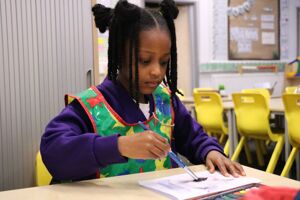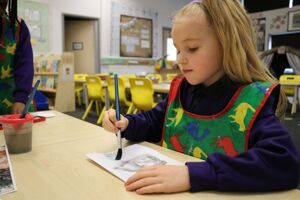- Home
- In the Classroom
- Subject Information
- Art
Art
BackIntent
At Academy 360, we strive to create an Art curriculum that engages and inspires children to express their individual creativity and to produce their own words of Art. Creativity is encouraged from the very beginning of our children’s school experience. Within EYFS, children are immersed in art in a child-initiated way, through Expressive Arts and Design. Across Years 1 to 11, pupils are provided with opportunities to experience a variety of media and techniques and are educated upon influential artists and craft makers from around the world, both past and present. Within Key Stage 2, our curriculum aims to equip children with the knowledge and skills to make informed choices, think critically of their own artwork and that of others, and to work with increased independence.
Implementation
This fulfils the statutory requirements outlined in the National Curriculum (2014). The National Curriculum for Art and Design aims to ensure that all pupils:
- Produce creative work, exploring their ideas and recording their experiences.
- Become proficient in drawing, painting, sculpture and other art, craft and design techniques.
- Evaluate and analyse creative works using the language of art, craft and design.
- Know about great artists, craft makers and designers, and understand the historical and cultural development of their art forms.
By the end of each key stage, pupils are expected to know, apply and understand the matters, skills and processes specified in the relevant programme of study.
At Academy 360, teachers plan sequences of lessons in Art based on objectives specific to their year group and the objectives that are taught link to learning of current topics. These learning objectives build on prior learning and develop art skills focusing on fundamental elements of Art.
- Drawing (including line)
- Painting (including texture)
- Collage and printing
- Sculpture (including form)
- Pattern, colour, shape and space
- Digital Media
Drawing
Exploring mark-making in all its forms, experimenting with line, tone and texture and using a wide range of materials to express ideas as drawings. Using sketchbooks to record observations about the world as drawings. Learning how drawing is used by artists to develop and communicate their ideas creatively.
Painting (including texture)
Developing proficiency in painting techniques (including exploring colour mixing), painting on a range of surfaces and applying drawing techniques to painting projects.Using sketchbooks to practise painting methods and exploring between different media within a piece of artwork.
Collage and Printing
Understand that the purpose of printmaking is to create multiple images and patterns. Printmaking offers the opportunity to explore cause and effect, for example, changing the amount of pressure applied while making the same print more than once. Printmaking also enables children to deliberately practise their knowledge of colour theory and colour mixing. Collage involves understanding the pliability of different materials and how objects/shapes fit together in a given space. Collage allows the children to explore a range of mediums and experiment with how they complement one another and understand how different materials change when glue, paint or other composites are added to them. Because of the mixed-media nature of collage, they are created as part of other units of essential knowledge.
Sculpture (including form)
Constructing and creating models with a wide variety of materials, investigating ways to express ideas in three dimensions. Developing the ability to adapt ideas and designs in sketchbooks, moving from two dimensions into sculpture.
Pattern, Colour, Space and Shape
Understanding the use of pattern, colour, space and shape to express individual ideas through artwork. Exploring a range of mediums and experimenting with how they complement one another.
Digital Media
Experiment with digital media to use a wide range of tools to create different textures, lines and tones, colours and shapes. The use of digital tools in art education increases artistic development and creativity, it is not limited by the physical features of the material world. In an ever-changing world, we need to prepare children for future careers that do not yet exist. A study conducted by the Institute for the Future (IFTF) and Dell Technologies, concludes that 85% of the jobs that will exist in 2030 have not even been created yet. All of these careers will exist because of the ever-changing nature of technology. The foundations of this begin in primary school.
We recognise the value art plays in the teaching of other subjects. Teachers are given the opportunity to teach units through cross curricular topics without losing the core art objectives. This allows children to make meaningful links, helping to strengthen and build connections in learning. We also extend our Art curriculum further by providing children opportunities to be creative in our Forest School, attend art and craft clubs and by entering local art events.
Also at Academy 360, during Spring term, the children have an opportunity to participate in a whole school project with an annual theme. The children are provided with a memorable experience that develops skill, children’s understanding of the diverse roles and functions of art in the wider world. In each year group the children are also provided with an educational visit linking with the specific topic or learning objective, this has been planned to have cross curricular links.
Impact
Our Art Curriculum is high quality, well thought out and is planned to demonstrate progression throughout the key stages. Our children will become creative learners, who have knowledge of both local artists and the great artists of the world. Creativity and innovations will be celebrated and children will become skilled at editing and improving the pieces they have created. As teachers, there will be an emphasis placed on individuality and children will be given the freedom to explore art using their imagination. Children will have embedded the key art skills needed to allow them to produce inventive pieces of artwork.
Assessment of children’s learning in Art is an integral part of this process through monitoring the children’s understanding, knowledge and skills during each lesson provided by the class teacher. Art is also monitored by the subject leader through sketchbook monitoring, lesson observations and pupil feedback to discuss their learning and understanding to establish the impact of the teaching taking place.
Primary
Position Statement
At Academy 360, the Art curriculum is linked to the wider topics taught in each year group. We believe that by making links between our wider topics and the teaching of Art, enriches learning and supports the children making connections across different areas of their education, helping us bring the curriculum to life with exciting opportunities, which contextualise teaching in a fun way for children.
Our curriculum offers children a rich range of opportunities within different disciplines of art and has been created in tandem with the Design and Technology curriculum to ensure a range of experiences for children in each year group, across the two subjects while also ensuring that any skills which overlap are developed throughout KS1 and 2. As well as more realised pieces of artwork towards the end of a project, sketchbooks are used as a tool to nurture creativity and form an integral part of children’s development in Art. In their sketchbooks, children are free to explore their ideas, share their opinions and record their experiences - they are encouraged to experiment and are taught that there are no right or wrong answers.
In Key Stage 1, children learn how to use drawing, painting and sculpture to develop and share their ideas, experiences and imagination, developing their mastery of techniques and a range of different materials in Key Stage 2. They are taught to evaluate, analyse and think critically about their own and others’ work; and gain a deeper understanding of how Art and Design reflects and shapes our history and how it contributes to the culture, creativity and wealth of our world.
To develop the teaching of Art within Academy 360, it is essential to continue to support staff in the teaching of Art to encourage ideas and individuality across the school. As well as, continuing to provide a comprehensive range of staff inset to cover all aspects of art that staff are not confident with. It would be beneficial to investigate ways in which the children would be given the opportunity to work with artists within our local community. In addition, to consider the possibility of pursuing an ARTSMART award.



Secondary
Click the link below to see our Secondary Art Curriculum
